Stories of Blossom review
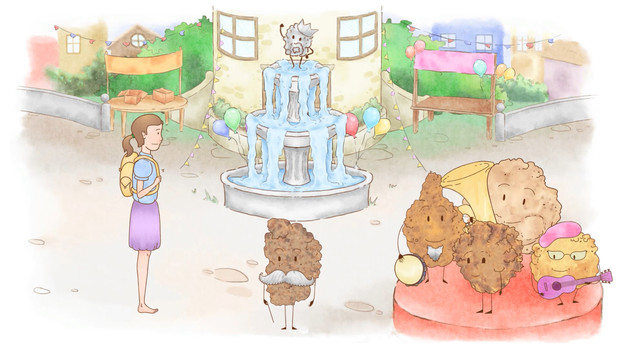
- 0 Comments
A charming, wonderfully accessible storybook adventure is sure to bear fruit in appealing to younger audiences
When I started high school, I was very nervous. I remember telling my Mum that I didn’t want to go and her telling me it would be fine, and besides, I had to go, there wasn’t a choice. I went from a fairly small primary school of a few hundred children to a large high school of 1500 kids, so that first day was overwhelming and daunting. Those feelings of being out of place, a little scared of the unknown, a bit anxious about what this new school would be like. I’m sure (looking back) I wasn’t the only one feeling that way.
That’s the sort of thing Stories of Blossom tries to capture, with fairy tales that help young Clara deal with these types of feelings, framed as an interactive storybook. These aren’t the Grimm kind of subversively dark fairy tales that feel childlike but are really aimed at a now-adult audience. Instead, this is a game aimed fully at young children. It’s not about high stakes or tragic loss. It’s simply about the exploration of places, ideas, and emotions. As an adult, I sped through it in a little more than two hours. So, to help me review something that I am clearly not the demographic for, I brought along my three children for the adventure (thirteen, ten, and seven years old).
Stories of Blossom is bookended by scenes of a grandfather and his granddaughter spending quality time together, with him using fairy tales to teach her valuable life lessons. The setup is usually Clara asking a question and Grampa telling her a story whose moral is the answer to her question. “Tomorrow is my first day back at school Grampa and… I’m worried no one will like me.” With soothing tones, Grampa replies, “Oh my dear Clara, you have no need to worry…. Have I ever told you the story about Annie and the Crumbles?”
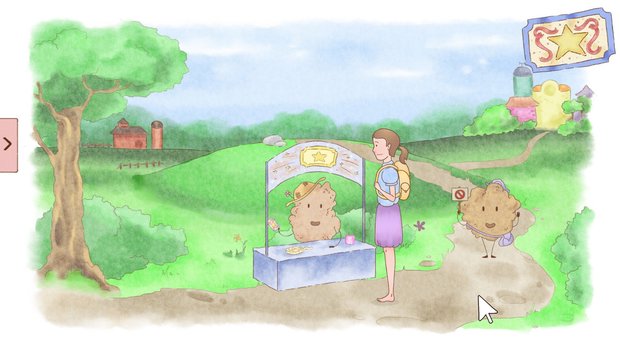
As told by Grampa, Clara is the third-person player character in each story, although her name is changed in all three since these are stories for Clara to help her, not actually about her. Each tale is unique, and must be finished in order the first time through, but once unlocked you can select which story you want to play from the ‘Extras’ button on the main menu. A useful feature for a return visit to Stories of Blossom.
The first story is about a normal girl helping a quaint village of cereal-shaped creatures, which assures Clara she doesn’t need to be worried that no one will like her, she just needs to be herself and she’ll easily make friends. The second story, “Millie and the Fungaloids,” sees an astronaut visiting a strange new world where she helps the local mushroom-type children find their missing items. Clara is a bit worried about what her future may hold, so Grampa tells this story to teach Clara to enjoy the journey instead of worrying about the destination so much. The third and final tale, “Captain Tutu and the Island of Everything,” is told in response to Clara’s complaint that everyone else has nice things but she doesn’t.
The plot of each story is very simple, which is perfectly fine for its target audience. In the first, for example, the ultimate goal is to save the Crumbles’ festival, which is being threatened by problems like the singer losing her voice. Each tale plays out by working through a number of small puzzles, which for an adult are relatively simple to work out. Find the voice and solve its problem so it will return to the singer, or rescue the seagull from being trapped under a rope. Each puzzle tends to build upon the previous one, so solve A to get to B so you can do C. One nice little feature is that some objects you pick up are used to solve multiple puzzles.
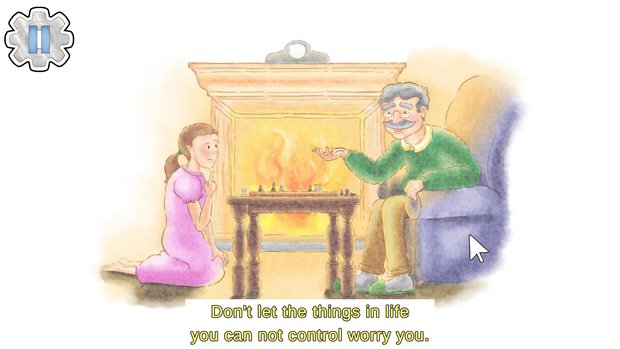
My seven-year-old particularly liked the character of the singer’s lost voice, as it’s portrayed in a whimsical way, illustrated as a real, fast-moving pink creature. This sort of imagery really made the whole fairy tale vibe come alive for the children and amused me as well. The level of imagination definitely appealed to all three, although my thirteen-year-old felt the whole thing was a bit babyish for someone his age – which, again, leads me to believe it was developed for younger children.
The highlight of Stories of Blossom is its artwork. Each scene (there are twenty-five in all) is drawn to resemble a storybook illustration, vivid and colourful with a painterly look bringing the varied worlds to life, which fits the nature of the game amazingly well. The Crumbles’ village is the most traditional fantasy land with an old-world English feel, even though it’s populated by villagers who resemble living, talking Corn Flakes. From trees to lakes, houses to the town square, everything looks beautiful in a way that really brings the world to life with a storybook charm.
The pirate story is, predictably, set on a tropical island with the usual tavern but also the more unusual swimming pool and cabana, but the planet visited in the second story appealed to me the most. Although drawn in the same painterly style, it’s filled with small fungus-like creatures living in a world of purple skies and green or blue alien-looking plants. With just a few clicks from the landing pad, you can travel to a wide variety of locations. A waterwheel and house, home to the Elder Fungaloid, is the first, followed by the alien township, which strangely seems to have only two buildings: a mail room and a bathhouse. Passing through the town, you’ll come upon a dreary swamp, illustrated with droopy trees and stagnant water.
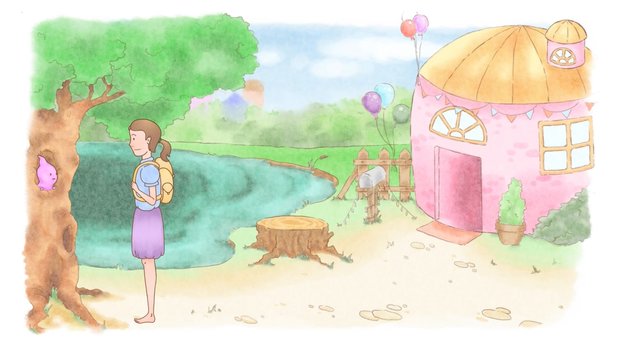
Whether she’s wearing a pink tutu with a pirate hat or an astronaut helmet, Clara is remarkably well drawn and animated and walks fluidly (if a touch too slow for my liking), although one quirk that is probably nit-picking is that her walk cycle continues through the current animation until it is finished after she stops walking. Both Clara and all the storybook characters have a subtle idle animation, just ever-so-slightly swaying, which gives off a feeling of life for the characters. However, there is minimal background animation besides things like water flowing and balloons floating on a string. The small number of them doesn’t take anything away from the immersion, though. I would even suggest that more would have taken away from the storybook quality of the worlds.
Having said that, where the animations DO feel lacking is in transitions. With the narrative framework of a story being told, whenever a big action occurs, instead of showing it as a cinematic cutscene, we instead switch back to Clara and Grampa carrying out a conversation overtop a series of still images from the story. This works well in separating the actual stories from the framing. However, it sometimes feels like a cost-cutting decision, because it’s easier and cheaper to draw one background with a voice-over rather than to show the action play out. In particular, the finale of each story would have benefitted immensely from more animation for a bigger emotional payoff. The standard storybook style doesn’t allow that; instead they’re made to feel the same as the rest of the chapter.
Each of the three stories is scored slightly differently, with the music nicely matching the environment while also maintaining a consistency throughout. The early adventure and the Grampa / Clara conversations sound similar with a light plucking guitar melody, while the pirate scenes, for example, add tropical island-esque drums to a more upbeat and jaunty tune.
One thing noticeably missing is voices for characters besides Clara and her Grampa. Instead, Grampa describes what the character says in a third-person manner. When talking to a small Fungaloid, Clara directly asks a question, but the response is given by Grampa where he says what the Fungaloid has replied. Handling the dialog like this is a tonally consistent design choice when you consider the framing device of Grampa telling his granddaughter a story. However, it’s equally fair to say that it feels somewhat lacking at times and, again, seems like cost-cutting. At the very least, maybe a better choice would have been to have Grampa put on different voices as he’s telling the story, as adults often tend to do when they read to their children.
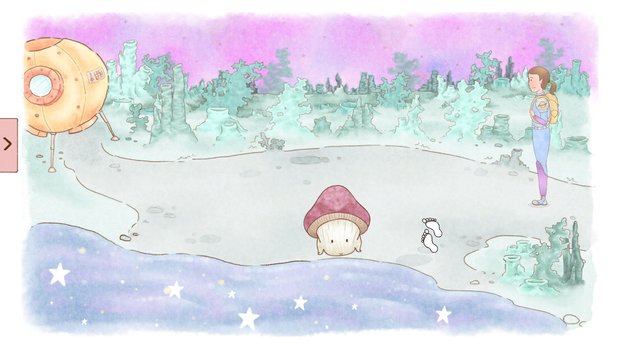
Every action is achieved by moving and left-clicking your mouse. Through each of the game’s unique environments, our hero will slowly walk where you guide her, with exits clearly marked by a signpost that appears when you hover the cursor on the edge of the screen, indicating the direction of travel. A useful feature is the ability to double-click an exit to instantly skip to that position. Objects or people that are interactive will highlight when you move the arrow cursor over them, and that arrow will change to resemble a hand if you can interact, or feet to walk. If you get into a menu or a conversation that you want to get out of quickly, simply right-click.
There is a menu you access by clicking on the folder tab on the left-hand side of the screen, which gives you access to settings, your backpack (which, as a side note, overcomes the usual adventure game trope of explaining where you keep all your items; our hero is literally wearing a backpack) and your diary. Each of these has clearly displayed buttons for navigation, such as ‘Back’ and ‘Exit.’
Click on the backpack to open your inventory, left-click again on the item you want to use, and the game will close the menu and your selected inventory item will be active and able to be used on whatever or whoever you decide. If you click the incorrect item on something, Grampa will let you know that it didn’t work as you suspected but may offer a clue. Clicking your pirate sword on a barrel in the third story, for instance, will give a response that you would rather try a non-violent approach. Right-clicking, again, resets the cursor to the standard arrow when holding an inventory item.
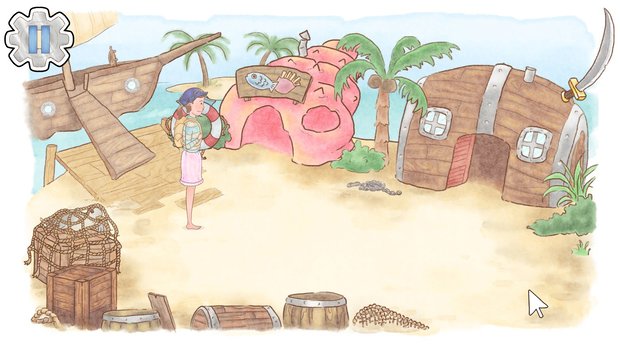
The diary offers a place to play through the tutorials, to review the story so far, and to look at your goals. The goals are actually a very simple hint system. For example, beneath ‘Goal: Save the Crumbles’ Festival’ is the next step in the puzzle itself, which is ‘Missing Jar of Sweeties,’ which then reveals the hint “Goal: Give the jar of sweeties to the decorator.” There is absolutely no way to get stuck here, even for children, because the hints are really that clear.
Beyond its traditional point-and-click mechanics, however, how you experience Stories of Blossom is largely up to you. Because of the sheer number of customisable options available, it was clearly important to the developers to make the game comfortably playable for those who are neurodiverse or have a disability, as detailed in their accessibility overview video. Knowing that, I will plant my flag on the hill and say that this is the single most customisable adventure game I have ever played. It feels like everything has an option available to help make your experience the best it can possibly be for you.
Let’s start with the obvious: Every single piece of text is spoken aloud. Clara and Grampa (Grampa serves as the narrator) of course, but also every menu and every button. If you go to save your game, hover over ‘Empty Slot’ and the game will say: “Empty Slot: Create a new save game.” That is how detailed the narration is. The only fault here is that, while the voices for the two main characters are both excellent, the voice of the menu and option narrator (different from Grampa the story narrator) is computer generated, and it has that uncanny valley edge to it that sounds uninspired and out of place.
Almost every aspect of gameplay is customisable through the settings menu. And that’s not hyperbole; I literally mean almost everything. The ‘Subtitles’ option allows you to turn the subtitles on or off, and decide whether to allow dialogue to advance on its own or require user input. Or you can choose to caption the music and other non-speech audio, whether to turn interaction labels on, or have the input prompts on or off (this puts a picture of a mouse on the screen with the correct button highlighted). You can change the text size and colour and decide if it should have an outline, choose whether to highlight hints and if the character speaking has their name displayed, and enable speaker intonation (a description on-screen that details the tone the character used). And that is only one of the four settings categories, the others being ‘Audio,’ ‘Input,’ and ‘Visuals,’ each with their own user-friendly options to choose from.
Final Verdict
If you have young kids, Stories of Blossom is definitely worth picking up. My thirteen-year-old lost interest very quickly and the first story about the Crumbles didn’t excite my ten-year-old, but my seven-year-old was the most engaged. He loved the storybook theme that held the whole game together, and was very invested in the more imaginative aspects of the stories, like the strange creatures and different worlds. It won’t pose any challenge at all for adults, but I would encourage you to take some children along for the ride as you’ll get a great deal of satisfaction from going on this journey together. Because sometimes the most compelling journeys are the simplest ones. You might not save the world or defeat an ancient evil, but you will see the world through a child’s eyes and imagination, and perhaps impart a few encouraging messages to your young ones while you’re at it.
Hot take
If a bedtime story and a classic point-and-click adventure game had a child, it would be Stories of Blossom. If you have kids you can play together with, or even to give them to play on their own, it is well worthwhile. It’s highly accessible for all, and even with a few noticeable cost-cutting measures, it’s a heart-warming and simple trio of fairy tales that any young child (and parents) should enjoy.
Pros
- Hand-painted background art is beautiful
- Stories will appeal to younger players
- The accessibility options are brilliant
Cons
- A lack of animations, particularly at important points
- No voices for the secondary characters
Shawn and his three kids played Stories of Blossom on PC using a review code provided by the game's publisher.


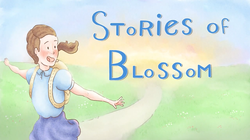




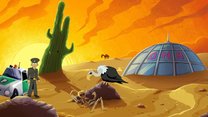


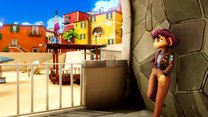
0 Comments
Want to join the discussion? Leave a comment as guest, sign in or register.
Leave a comment